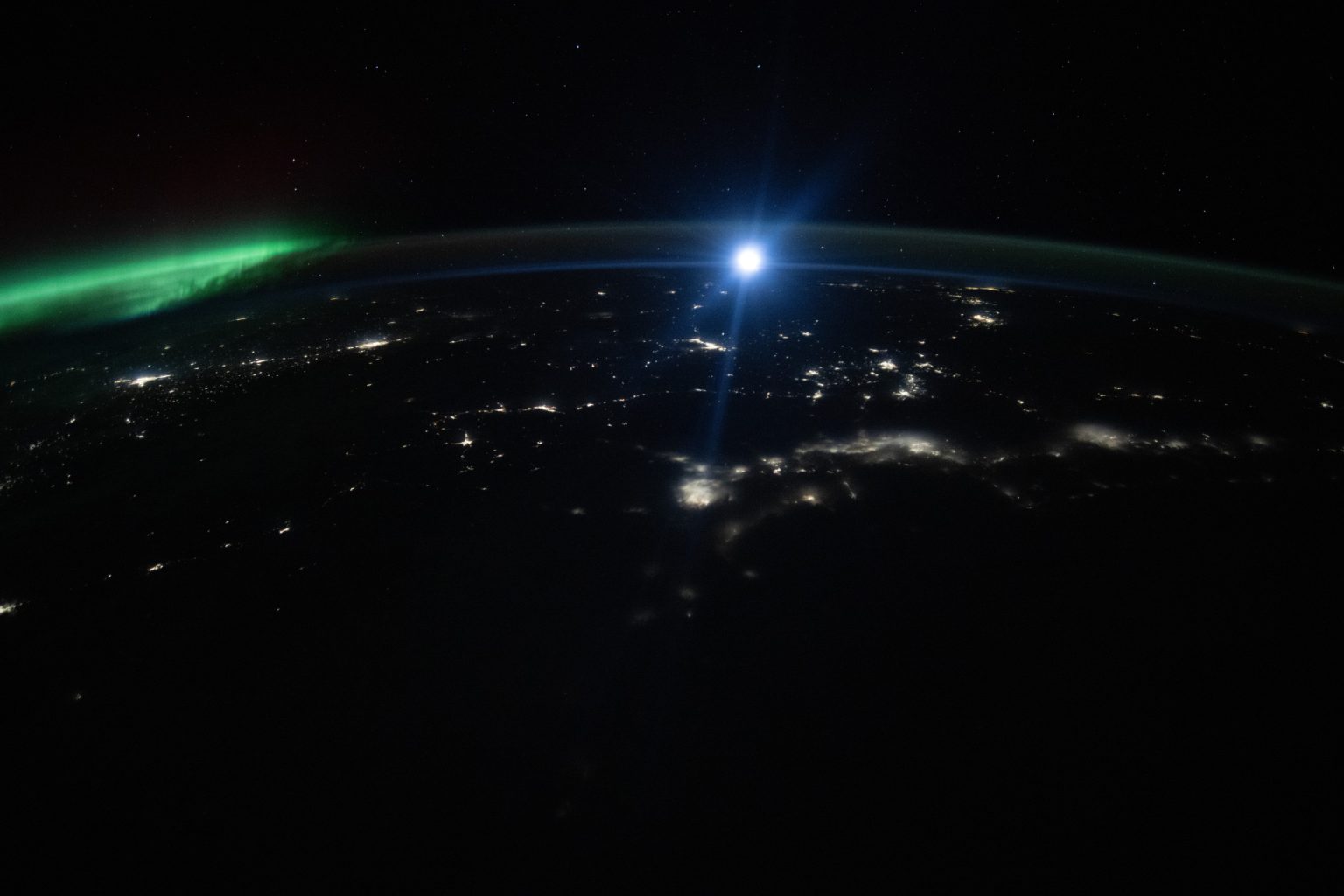A Celestial Symphony: Astronaut Captures Moon and Aurora Borealis from Space
In a breathtaking moment of cosmic convergence, an astronaut aboard the International Space Station recently captured an extraordinary photograph that showcases both the moon and the aurora borealis illuminating the night skies over the northern United States West Coast and Canada. The image, taken on March 19, reveals a tapestry of natural and human light sources – from the ethereal glow of the aurora to the clustered city lights of major urban centers including Calgary, Edmonton, Portland, Seattle, and Vancouver. What makes this image particularly striking is the juxtaposition of these elements: the bright pinpoints of human civilization below, the luminous green curtain of the aurora dancing across the Canadian sky near Edmonton, and the moon just beginning to rise above Earth’s curved horizon. Seattle and Vancouver appear slightly blurred in the photograph, which NASA attributes to weather conditions at the time the image was taken. This single frame captures the remarkable intersection of celestial mechanics, atmospheric physics, and human development in a way that few other perspectives could offer.
The astronauts aboard the International Space Station experience our world in ways fundamentally different from those of us bound to Earth’s surface. Orbiting at approximately 17,500 miles per hour, ISS crew members witness an accelerated cycle of cosmic events – including about 16 moonrises and moonsets within each 24-hour period. This relentless orbital pace provides them with unique opportunities to document fleeting atmospheric phenomena that might otherwise go unrecorded. The station’s position above Earth’s atmosphere offers an unfiltered view of these celestial displays, without the visual distortion that observers on the ground must contend with. From this privileged vantage point, astronauts routinely capture images that not only serve scientific purposes but also connect humanity with the broader cosmic environment in which our planet exists – reminding us of the delicate interactions between Earth and the rest of the solar system.
The aurora borealis visible in the photograph represents a direct connection between our Sun and Earth. These northern lights are created when charged particles from solar eruptions interact with molecules in our planet’s upper atmosphere. The brilliant green color seen in the image is primarily produced by oxygen atoms becoming excited at specific altitudes, typically around 60-150 miles above Earth’s surface. Had the aurora displayed red, purple, or blue hues, it would have indicated different interactions: red typically comes from oxygen at higher altitudes, while blue and purple result from nitrogen molecules. The diverse palette of aurora colors reflects the complex chemistry of our atmosphere and its response to solar activity. What makes this particular aurora sighting noteworthy is its visibility at relatively low latitudes, a phenomenon consistent with the current period of heightened solar activity known as the solar maximum.
This image arrives during a significant period in our Sun’s cyclical behavior. The Sun is currently experiencing its solar maximum – the peak of activity in its roughly 11-year cycle. During this phase, which began in October 2023 and is expected to continue through 2025, the Sun’s magnetic field undergoes dramatic changes, including a complete reversal of its magnetic poles. This transition period is characterized by increased solar eruptions, including solar flares and coronal mass ejections that send streams of charged particles toward Earth. These particles, when interacting with our planet’s magnetic field and atmosphere, produce the enhanced auroral displays captured in the astronaut’s photograph. The current solar cycle, designated Solar Cycle 25, has produced unusually strong activity, allowing auroras to be visible much farther south than typical – sometimes reaching as far as central Mexico during particularly intense solar storms.
The extraordinary reach of these auroral displays reflects the interconnected nature of our solar system. While the aurora is a beautiful spectacle, it also serves as a visible reminder of the invisible electromagnetic relationships between Earth and the Sun. The solar wind – a constant stream of charged particles flowing outward from the Sun – shapes and compresses Earth’s magnetic field, creating a protective bubble called the magnetosphere. When solar storms temporarily overwhelm this shield, charged particles can penetrate deeper into our atmosphere along magnetic field lines near the poles, creating more intense and widespread auroras. Scientists closely monitor these interactions not just for their beauty but because powerful solar storms can potentially disrupt satellite communications, power grids, and other technological infrastructure. Images like this one help researchers track and understand these space weather patterns while simultaneously captivating public imagination.
As Solar Cycle 25 progresses through its maximum phase, scientists anticipate continued auroral activity before a gradual decline toward the next solar minimum. The current cycle is expected to wind down over the coming years, with Solar Cycle 26 likely beginning sometime between 2029 and 2032. This predictable rhythm of solar activity has been observed and documented for centuries, though modern space-based observations provide unprecedented detail about these processes. For the astronauts aboard the International Space Station, photographs like this one represent more than just stunning visuals – they’re part of an ongoing scientific mission to monitor Earth’s relationship with our star. Each image helps tell the story of our planet’s place in the cosmic neighborhood, a narrative written in light across the night sky. Whether viewed from space or from the ground, these auroral displays remind us of the dynamic, ever-changing nature of our solar system and the unique planet we call home.


